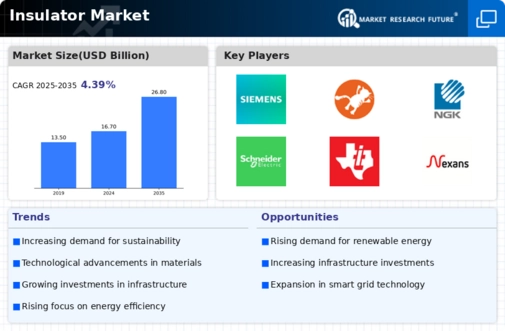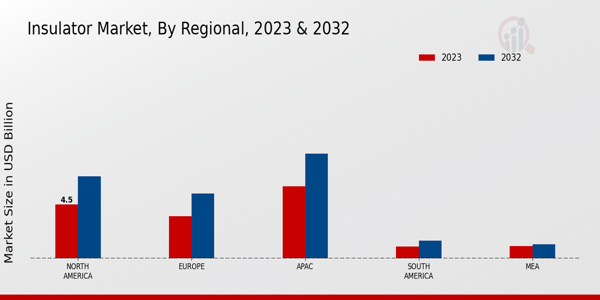Market Trends and Projections
The Global Insulator Market Industry is projected to experience notable growth, with a market value of 16.7 USD Billion in 2024 and an anticipated increase to 26.8 USD Billion by 2035. This growth trajectory suggests a compound annual growth rate (CAGR) of 4.4% from 2025 to 2035. Various factors, including the rising demand for renewable energy, infrastructure development, and technological advancements, are expected to drive this expansion. The market's dynamics indicate a robust future, with insulators playing a crucial role in supporting the evolving energy landscape.
Growing Demand for Renewable Energy
The transition towards renewable energy sources is a prominent driver in the Global Insulator Market Industry. As countries strive to meet sustainability goals, the demand for wind and solar energy systems is increasing. These systems require high-quality insulators to ensure safety and efficiency. For instance, the installation of solar panels and wind turbines necessitates advanced insulator technologies to withstand environmental stresses. This trend is expected to contribute to the market's growth, with projections indicating a market value of 16.7 USD Billion in 2024, potentially rising to 26.8 USD Billion by 2035.
Infrastructure Development Initiatives
Infrastructure development initiatives across various regions are significantly influencing the Global Insulator Market Industry. Governments are investing in modernizing and expanding electrical grids to accommodate growing energy demands. For example, the construction of new power plants and transmission lines requires robust insulators to ensure reliable electricity distribution. This investment in infrastructure is likely to drive the market forward, as the need for durable and efficient insulators becomes paramount. The anticipated growth in this sector aligns with a projected CAGR of 4.4% from 2025 to 2035, reflecting the increasing importance of insulators in modern infrastructure.
Regulatory Standards and Safety Compliance
Regulatory standards and safety compliance are pivotal factors influencing the Global Insulator Market Industry. Governments and regulatory bodies are establishing stringent guidelines to ensure the safety and reliability of electrical systems. Compliance with these standards necessitates the use of high-quality insulators that can withstand extreme conditions and prevent failures. For example, the implementation of safety regulations in the electrical sector drives manufacturers to innovate and produce insulators that meet these requirements. As safety becomes a priority, the demand for compliant insulators is likely to rise, contributing to the overall growth of the market.
Increasing Urbanization and Electrification
The rapid pace of urbanization and electrification in developing regions is a critical driver for the Global Insulator Market Industry. As urban populations grow, the demand for reliable electricity supply increases, necessitating the expansion of electrical infrastructure. Countries in Asia and Africa are particularly focused on enhancing their power distribution networks to meet the needs of burgeoning urban centers. This trend not only boosts the demand for insulators but also encourages investments in modern technologies. The market is poised for growth as electrification efforts continue to expand, reflecting the essential role of insulators in supporting urban development.
Technological Advancements in Insulator Materials
Technological advancements in insulator materials are reshaping the Global Insulator Market Industry. Innovations in composite materials and ceramics are enhancing the performance and durability of insulators. These advancements allow for better resistance to environmental factors, such as temperature fluctuations and pollution. For instance, the development of polymer insulators has gained traction due to their lightweight and high-performance characteristics. As industries seek to improve efficiency and reduce maintenance costs, the demand for these advanced materials is expected to rise, further propelling the market's growth in the coming years.






















